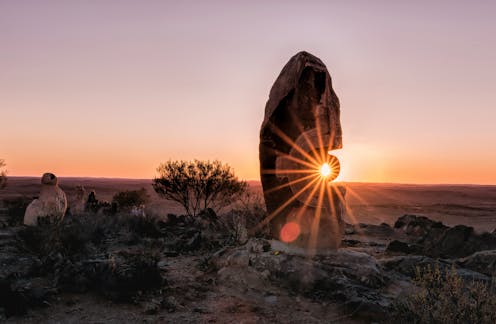Mystery, outback horror and a wandering protagonist propel Gail Jones’ The Name of the Sister
- Written by Robbie Moore, Senior Lecturer in English, University of Tasmania

A side plot in one of Gail Jones’s most celebrated novels, The Death of Noah Glass (2018), involves a film-loving man who has recently lost his sight. Benjamin is desperate to enjoy thrillers again. He remembers watching, before his vision faded, the silhouette of James Bond, as iconic as a Caravaggio, taking aim down the camera aperture during the opening credits.
But the app Benjamin is using to describe movies is “mechanical and unimaginative”, so he hires former philosophy academic Evie Glass to provide live descriptive audio. She is not the Bond type:
The advertisement asked for a three-hundred-word biography. Nothing more. Evie had composed a florid and somewhat metaphysical note, which ended: ‘curious about the invisible that lies beyond the visible’.
Evie is left to ponder how to transpose Hollywood spectacle into words: “how she would describe bashings and fisticuffs, and police cars hurtling in elastic slow-motion twists as they crashed.”
Review: The Name of the Sister – Gail Jones (Text Publishing)
Jones’s latest novel, The Name of the Sister, has a similarly detached and denatured relationship with thrillers. It begins in classic genre territory: a young woman is found stumbling down an outback road north of Broken Hill, without the power of speech and without an apparent identity. The police begin to suspect that this “Unknown Woman” has escaped from an assailant holding her captive in an abandoned mine.
Angie is a familiar Jonesian figure, more interested in the layering and patterning of images, in suggestion and resonance, than in firmly drawn connections and resolutions. As Jones herself asked in her essay A Dreaming, A Sauntering (2006): “What might it mean to take the fragment or the trace as a paradigm of knowledge and to assume that assemblage, not reconstitution, is our critical task?”
But thrillers are all about firmly drawn connections and resolutions: solving the crime, cutting the red wire, completing the quest. So Angie is unsuited, temporally, to the linear propulsion of the thriller and the opening half of the novel resists its pull. Instead of solving the mystery of the Unknown Woman, she multiples it. She is drawn to people who approach the police with the belief that the Unknown Woman is their lost loved one, who project their grief and desire onto the woman’s silence.
The first half of the novel sits with these feelings, while exploring Angie’s brittle marriage and midlife dissatisfaction. Like Hamlet (the play Sam is directing at his school), The Name of the Sister delays the deadly downward rush into plots and plotting.
But Angie becomes one of those noir protagonists who gets pulled into a thriller plot almost by accident. Suddenly, she is travelling to Broken Hill to meet her old friend, a police officer, and sniff around for local colour. Dank Elsinore is exchanged for the “powdery, orange light” of Wake in Fright.
In Broken Hill, the horror of the underground kidnapping plot is linked to the horror of the extraction economy and its “tyranny of the inert: machines, wrecks, holes, slag and mullock dumps”. The extractive image-mining of the culture industry, with its instrumentalisation of the landscape for profit, is also, implicitly, part of the horror.
The fragments begin to cohere. Angie’s store of literary allusions, her love of words, her sensitivity to resonant images, help her to see (she believes) the shape of a crime that no one else can see. The digressive opening narrows down to the thin track of a dirt road, heading to the horizon, and accelerates toward a surprising conclusion.
Following the mind of its wandering protagonist, The Name of the Sister is a novel about many small things. Jones writes beautifully about the slow erosions of marriage and friendship, about middle-age, about grief and cruel optimism, about the pleasures of music, torrential rain, aimless walking, the non-place and non-time of a long train journey.
These pieces coalesce into a rich and suggestive novel about the very meaning of plots and plotting, the ideas and feelings we project onto unknowns, and the connections we draw to give events shape and significance.
Authors: Robbie Moore, Senior Lecturer in English, University of Tasmania





